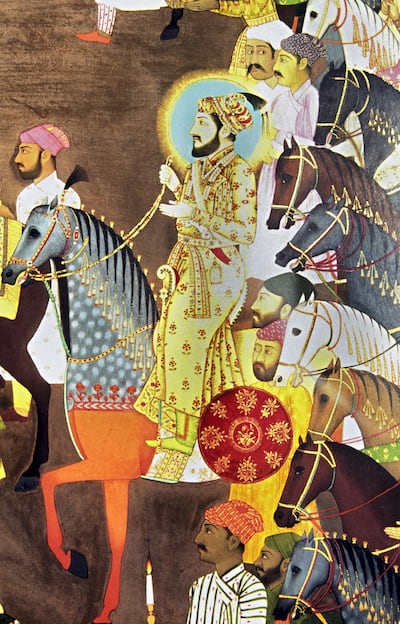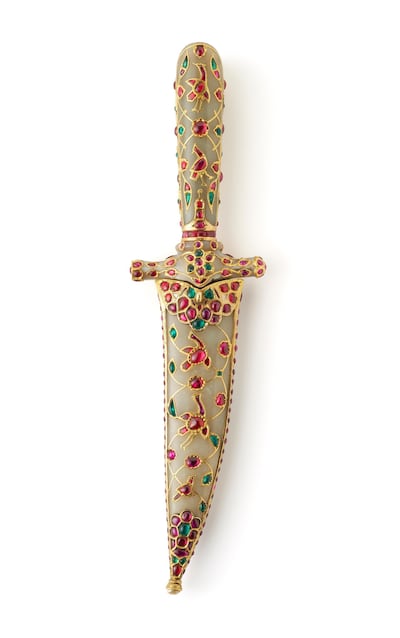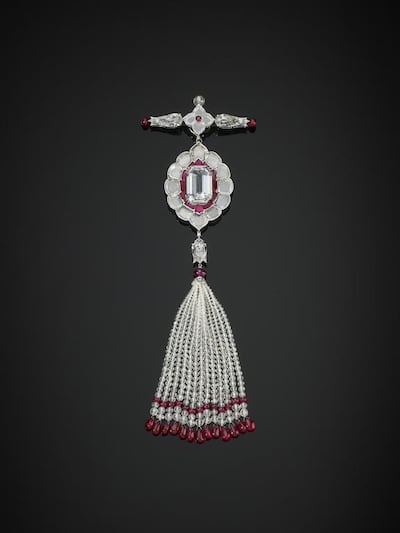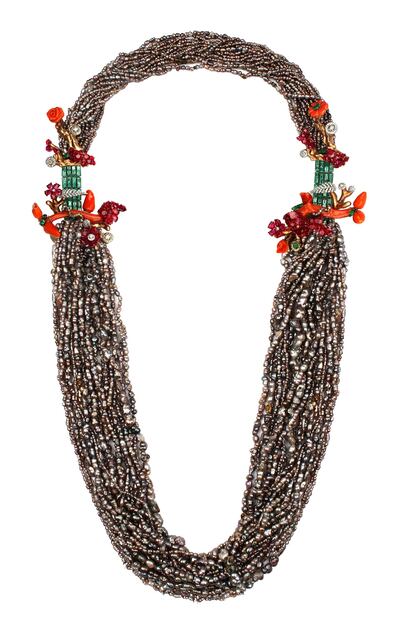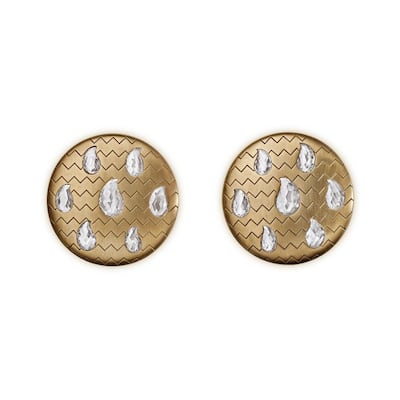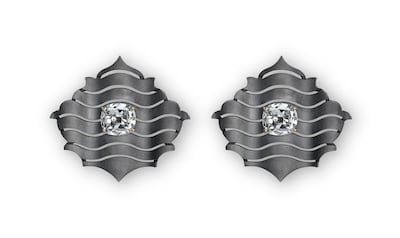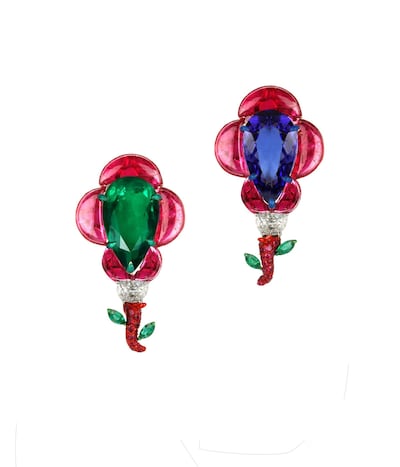India is the land of colour: of ruby reds, emerald greens, sapphire blues and the countless hues of diamonds, from vivid yellow to the rare, softly luminous white that emerged from the legendary Golconda mines. The country is as famous for the vivid cast of its jewellery as it is for its spectacular architecture and exquisitely embroidered textiles.
The jewellery that sparkles in the vitrines of India’s family jewellers today owes its stylistic roots to the Mughal emperors who ruled India for 300 years until 1858. They maintained a court renowned for its wealth, high culture and love of precious objects, in particular jewellery.
Akbar I, who ruled until 1605, and his son Jahangir, were obsessed with jewellery, while Jahangir’s son Shah Jahan was a connoisseur of gemstones and carvings. The emperors had first pick of all the gems that came out of their mines and after Shah Jahan’s son Aurangzeb captured Golconda, the Mughals controlled the only known diamond mine in the world at that time.
The Mughal era was the zenith of Indian jewellery design: craftsmen developed the gem-setting technique known as kundan, in which pure 24K gold foil is fused at room temperature around uncut diamonds and gemstones, resulting in unparalleled freedom for the jewellery artists to realise their designs. The Mughal style was an amalgamation of Islamic and Hindu elements, featuring stylised forms of nature and symbolic motifs, while the different gemstones were (and still are) charged with talismanic properties.
Jewellery is still part of Indian culture, as central to everyday life as it is to adornment and beauty, and passed from generation to generation through dowries, rituals and inheritance. Yet no one could outdo India’s erstwhile maharajas for the sheer quantity and opulence of their jewels, which were worn to reflect the majesty of their owner.
To European travellers of the time, the sheer quantity of jewels worn by these royals was a constant source of astonishment. The Victorian artist Valentine Cameron Prinsep was overwhelmed to see that dressing Maharaja Tukoji Rao Holkar II of Indore took no less than six men, four of whom would “stand around with trays, on which are displayed jewels worth I do not know how many lakhs”.
Another observer, Yvonne Fitzroy, wrote in the 1920s how the Maharaja Bhupinder Singh of Patiala was so richly jewelled that “his brocaded coat was entirely concealed by diamonds”.
It is not surprising that the great jewellery houses of Europe beat a path to these palace gates, eagerly securing commissions to revamp royal treasures. The maharajas appreciated the aesthetic of contemporary European jewellery and were enthusiastic about resetting their treasures in the latest western styles. Houses such as Cartier and Boucheron were entrusted with the task of reworking the jewellery in platinum (a stronger material than 24-karat gold), while also learning to blend the best of Mughal design, gem cuts and colours with western design experience, from which emerged the Art Deco style.
Ironically, Indian jewellery today remains largely rooted in ornate Mughal design and the kundan technique, and has not really evolved with the speed witnessed in other parts of the world.
Bina Goenka, one of India’s three leading contemporary high jewellery designers, says: “When you look back to the Mughals and maharajas, they went to jewellers who were ahead of their time. They did not embody what was already available in India, they went to people who could take their jewels and do something spectacular.”
She believes that many of the leading family jewellery businesses in India today should follow this lead and learn to be more adventurous, rather than sticking with established design traditions.
One jeweller who is definitely not resting on his family heritage, but instead moving high jewellery into new territory, is Krishna Choudhary of Santi Jewels (named after his father), who combines historic gemstones with contemporary design and materials such as titanium and platinum.
A pair of earrings features paisley-cut diamonds (reshaped from pears) on Mughal-inspired chevron-patterned gold discs, while four 17th-century carved emeralds form the petals around a portrait-cut diamond set on a ring. “It is a responsibility to do justice to historic gemstones like these,” he says.
The chevron design of the earrings is a favourite. “I learnt these patterns and motifs from my studies of Islamic and Indian art,” he says. “I think it is the Islamic flavour of my designs, the stones, the colours and the volume that appeal to my clients in the Middle East. They love the deep colour of emeralds; it’s a lucky colour, and they love sapphires, although sapphires are not popular in India.”
Reflecting the way Parisian jewellers and maharajas would collaborate, there is a cross-pollination of ideas and techniques in Choudhary’s work. He is sourcing old gemstones that were mined 150 years ago and setting them at workshops in Paris and Milan, in designs that celebrate India’s heritage in a contemporary way. Choudhary splits his time between London and Jaipur, which is the capital of coloured gemstone cutting and dealing. The Pink City, founded in 1727, is the prime place to find specialists in the art of enamelling, gem carving, bead manufacture and jewellery production, while Mumbai is India’s powerhouse for cutting and polishing diamonds.
Choudhary’s ancestors were one of the first families to move to Jaipur and became the palace bankers responsible for minting coins. The family amassed a spectacular and rare collection of art treasures and eventually moved into jewellery-making.
Choudhary is the 11th generation and heir apparent to the discrete family business. His father runs Royal Gems & Art from the family’s historic haveli in the city. Choudhary grew up handling important and rare emeralds, natural pearls, spinels and Golconda diamonds, and these resources find their way into Santi jewels. “You would find these pieces behind glass in a museum, but I have got the opportunity to find and do something with them,” he says.
Choudhary doesn’t interfere with historic stones by recutting them. Instead, he works with them, creating, for example, a pair of old mine cushion-cut diamonds floating on undulating waves of titanium, shaped into Mughal cartouche earrings.
Choudhary is a newcomer to the contemporary high jewellery world, launching Santi Jewels only last year, joining India’s two other highly respected names, Viren Bhagat and Bina Goenka. Bhagat, who lives in Mumbai, remains virtually unknown outside a tiny circle of connoisseurs and clients, but his work is spoken about with the same hushed awe as that of JAR, the New York-born Joel Arthur Rosenthal, the jewellery world’s superstar. The publicity-shy Bhagat’s pieces sells for small fortunes, but that does not seem to hold back his mostly western clientele. His designs are inspired by textiles, architecture and miniature paintings in a style that melds Mughal motifs and Art Deco sensibilities.
While Bhagat and Choudhary come from jewellery dynasties, Goenka is an outsider, completely self-taught, who began her journey into high jewellery as a young mother in the 1990s looking for something creative to do while caring for small children at home. She sees that as an advantage. “I started with a fresh mind and fresh concept and give my craftsmen their dues,” she says.
The price of her jewellery is dictated by its design and craftsmanship, and the settings are almost invisible – whereas in India, the price traditionally depends on the weight of gold incorporated in the jewellery. Goenka’s pieces are contemporary, much lighter and easier to wear.
The former lawyer, who lives in Mumbai, is passionate about Indian craftsmanship and after frustrating early attempts at getting jewellery made to her exact specifications, she did some research into running a workshop and set up her own facility, with only one craftsman. She would buy the gems herself. “I spent days drinking cups and cups of tea in the bazaar, buying blue topazes, citrines and amethysts, and began to realise my strengths lay in design and mixing unbelievable colours,” she says. “Colour and craftsmanship became my forte.”
Goenka graduated on to stunning conch and clam pearls, emeralds and rubies, working closely with Muzo in Colombia and Gemfields, the sustainable mining company that supplies emeralds from Zambia and rubies from Mozambique – sustainable sourcing is a central tenet to her business. Her designs are brave, bold and technicoloured, inspired by nature and full of movement.
By 2007, Goenka’s business had grown to such a scale that she established her eponymous label. Now her one-of-a-kind jewels are widely sought after internationally. She began with larger pieces but has evolved into smaller designs, such as gorgeous drop earrings smothered in rubies or emeralds. The designs resonate with her Middle Eastern customers.
“I began by making big necklaces thinking that is what they wanted, but soon corrected myself,” she says. “Their tastes are very refined and sophisticated: they like large gemstones in smaller jewels or small stones in large pieces.”
All the same, Goenka’s palette remains deeply rooted in that Indian passion for colour.

